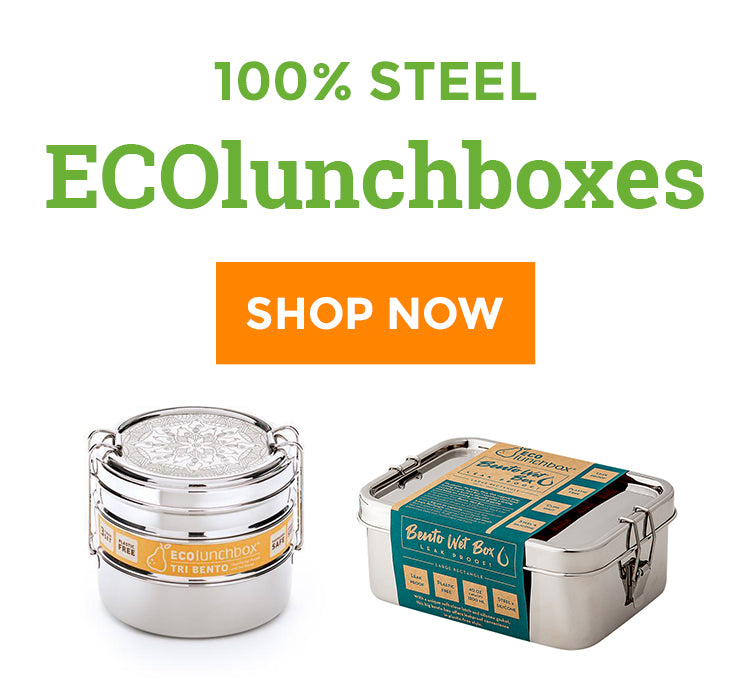Why No Metal in Microwave?

Healthy options for reheating your leftovers!
Microwaves are the popular choice for reheating foods stored in containers - be they last night’s leftovers or a packed lunch. We get questions from our eco-friendly customers all the time about whether food can be reheated in the microwave in our stainless steel lunch boxes.
So, can you put stainless steel in the microwave? No, ECOlunchboxes are not microwave safe. That’s true for all metal, including stainless steel and tin foil. Metal functions like a mirror in the microwave, reflecting the oven’s light waves and creating sparking, fire and, if the appliance is not turned off immediately, the microwave could even explode.
Before we explore whether or not microwaving food is a healthy choice, let’s remember there are many convenient ways to reheat food in metal containers, like ECOlunchboxes, without microwaving. Be sure to use an oven mitt or stainless steel pot gripper when handling hot metal containers!
Conventional Oven or Toaster Oven: A toaster oven is a great alternative to a microwave, especially at the office. Our ECOlunchbox containers are ideal for reheating food in the toaster or regular oven.
Convection Oven: These ovens significantly speed up roasting and baking by circulating hot air. You will be able to reheat in a fraction of the time.
Stovetop: For fast stovetop heating, empty food from your ECOlunchbox into a frying pan. Add a splash of water to the pan for moisture, cover with a lid to add some steam, and your food will be hot in about 5 minutes.
Instant Pot: The first step is lowering your metal lunch box full of food into the Instant Pot. Use a silicone sling with straps to lower your stainless steel container into the pot. If you aren’t in a rush and want to warm your meal slowly, use “Slow Cook” function or “Keep Warm” functions. If you want to reheat food more quickly, “Steam” function is best. Either way you need water to make steam. So add at least a cup of water to the bottom of the insert pot of your instant pot before you begin. When your food is hot, lift your stainless steel container out of the pot using the handles on your sling accessory.
Sous-vide / Steamer: This can also be a good idea so long as plastic pouches, which have become popular lately, are avoided due to the risk of leaching bisphenol contamination. In this cooking method, food may be put in a non-toxic, tightly sealed silicone pouch, such as a Stasher Bag, and submerged for gentle reheating.
When it comes to reheating food in our metal ECOlunchboxes, avoid submerging the steel and silicone containers. Food and air when heated expands and our silicone lids will likely pop off with the pressure if submerged in hot water. Instead, put your ECOlunchbox (with or without a lid) full of food into a steamer basket over simmering water and top with a snug lid. Wait approximately 5 minutes for it to heat through.
Slow Cooker: These are excellent for make-ahead meals, casseroles, etc. and most have a “warm” feature. Pop your ECOlunchbox in until toasty!
Why plastics and microwaves don’t mix
Often we meet eco-friendly consumers at community events who don’t know very much about microwaving.
These lunch packers are putting care into packing nutritious lunches, including leftovers, and even seeking to avoid unnecessary waste by using reusable containers. Unfortunately, more often than not, they’re often choosing light-weight, leak-proof, BPA-free plastic containers instead of non-toxic steel or glass containers.
So why would they choose plastic instead of steel or glass? They want something that’s light, won’t break and can be used in the microwave.
The health concern is that plastic is a petroleum-based material that contains estrogen-mimicking chemicals like bisphenol-A (BPA). Even BPA-free plastics are risky from a health perspective since BPA is substituted for BPS (bisphenol substitute) a similar but more toxic hormonal chemical.
Radiation, plastic, and toxins
When heated in a microwave, plastics react to the radiation waves by releasing these toxins, among others, into the food. Glass is a better choice for microwaving, but in general radiation waves from microwaves are to be avoided due to human health concerns. Additonally, food retains its nutritional value better when reheated conventionally on the stovetop, toaster oven and other ways described above.
When we explain that steel containers, like ECOlunchboxes, which are ideal for to-go foods because of their lightweight and unbreakability, would be a great substitute for their plastic containers, they usually say they wouldn’t be open to change because they’d need to heat their food before serving in a microwave. That’s what prompted us to write this blog laying out the many options available to people seeking to reheat food in microwave-safe steel containers!
So next time you reflexively start to put food in a microwave, think again. Try using a different reheating method to maximize the nutritional goodness of your meal. Plus, food tastes so much better when it’s not microwaved. You’ll barely miss the few extra minutes it takes to heat something up the old-fashioned way.
P.S. For people who strongly want to keep using their microwaves, only use glass while you keep educating yourself about this lesser-understood issue.





